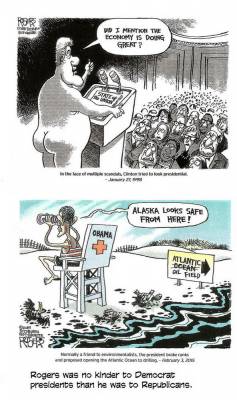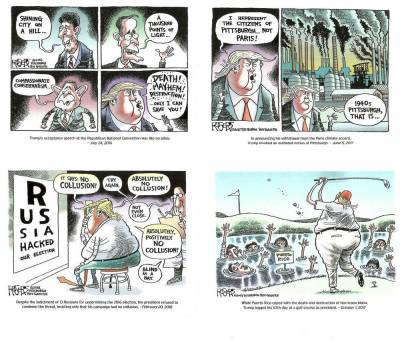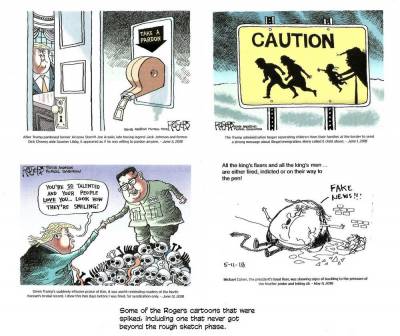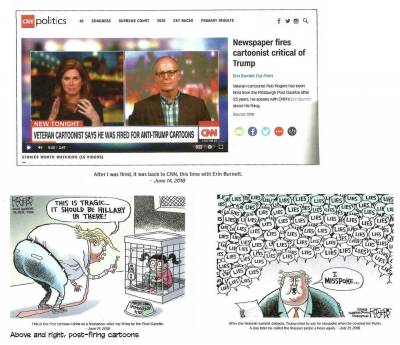Book Review – Enemy of the People: A Cartoonist’s Journey, by Rob Rogers
Foreword by Jake Tapper; 182 8.5x11-inch pages, b/w and color; 2019 IDW paperback, $24.99 (Scroll down to see some of Rogers' cartoons!)

“ENEMY OF THE PEOPLE” is an ironic title for this collection of Rogers’ cartoons. In deploying the tag the Trumpet has affixed to hostile news media, editoonist Rob Rogers [ed: full disclosure, Rogers is regularly featured in the Humor Times monthly political humor magazine] describes himself: as a highly critical commentator on the trumperies of the current administration, he was just the enemy Trump had in mind.
And for that, Rogers was fired June 14 last year. “I blame it on Trump,” Rogers said in the social media message announcing his fate.
And he was, in a manner of speaking, absolutely right.
He was fired because he was drawing too many cartoons critical of the Trumpet. And his paper, the Pittsburgh Post-Gazette, where he’d spent the last 25 years of his 34-year career as a political cartoonist, wanted to support Trump, uncritically.
It was every editorial cartoonist’s nightmare—to be fired for expressing your opinion when expressing your opinion was what you’d been hired to do. Rogers had been expressing his opinion at the Post-Gazette for decades; then, all of a sudden—Boom!
The week before he was fired, none of his cartoons appeared in his paper. He’d drawn one every day, but the Post-Gazette management didn’t like any of them. Too much anti-Trump. They were all spiked. Then Rogers was, too.
As soon as the news of his firing broke, professional organizations immediately voiced their alarm. The number of editorial cartoonists nationwide has been steadily shrinking, and that, in combination with the hostility of the Trumpet to news media, makes Rogers’ firing seem an omen. At least, ominous.
The Asssociation of American Editorial Cartoonists, where Rogers had served a term as president, said: “Management of the Pittsburgh Post-Gazette just demonstrated disdain for their readership and lack of concern about declining circulation by firing their cartoonist of twenty five years, Rob Rogers. … The firing of Rogers and the absence of his cartoons from the editorial pages is a blow to free expression and to the existence of a free and open marketplace of ideas.”
Michael Cavan at the Washington Post’s Comic Riffs quoted the National Cartoonists Society. “NCS, which represents hundreds of member cartoonists and other comics-industry professionals, said Thursday in a statement that it ‘is saddened by the news that our friend and fellow member, Rob Rogers, was fired from his longstanding job at the Pittsburgh Post-Gazette. The NCS supports Rob in his efforts to maintain his integrity in expressing his ideas and viewpoint, and stands against any form of censorship or suppression of free speech.’
“The NCS said that Rogers is ‘a very talented cartoonist and we’re confident that he’ll find a new home for his art at a publication that will appreciate his unique gifts.’”
The Newspaper Guild of Pittsburgh said that “Rob Rogers is a true talent we were honored to know as a colleague and friend. [He isn’t a member.] He deserved much better treatment.” The Guild said in its statement that the only apparent transgression by Rogers — a past Pulitzer Prize finalist — was “doing his job.” The union also pointed to “the new order of the Post-Gazette editorial pages” reflecting the “pro-Trump, pro-conservative orthodoxy” of the publisher and editorial director.
“Given the recent killing of a number of Rob’s cartoons critical of President Trump and conservative positions, favorites of the publisher and editorial director, it perhaps is not surprising that this sad day for the Post-Gazette, the Pittsburgh community and journalism has arrived,” the Guild statement read.
Pittsburgh’s mayor, William Peduto, released a statement: “The move today by the leadership of the Pittsburgh Post-Gazette to fire Rob Rogers after he drew a series of cartoons critical of President Trump is disappointing, and sends the wrong message about press freedoms in a time when the press is under siege. This is precisely the time when the constitutionally-protected free press – including critics like Rob Rogers – should be celebrated and supported, and not fired for doing their jobs. This decision, just one day after the President of the United States said the news media is ‘our country’s biggest enemy,’ sets a low standard in the 232-year history of the newspaper.”
Rogers had always posted his cartoons on social media after giving them to his editor at the paper, and when the paper’s readers noticed that these cartoons didn’t also appear in the Post-Gazette, they knew something was up. And numbers of them protested the disappearance of Rogers’ cartoons the week before the firing, picketing the newspaper’s office.
And the paper’s union reporters and non-union editors (who do not enjoy union protection) joined in taking out ads in their own paper distancing themselves from the publisher’s views, which the ads pointedly disavowed. Unprecedented, absolutely.
The ads emphasized that the news department of the paper was independent of the editorial department. While the ads didn’t mention Rogers, an accompanying statement did:
After describing its members as “shocked” at the termination of Rogers’ employment, the union’s statement continued:
“Rogers’ firing has created a firestorm of criticism by readers, many of whom have canceled their subscriptions and have urged others to do so. Readers’ ire also has even been heaped upon newsroom employees because the public does not understand that the staffs of the newsroom and the editorial pages are separate and do not work with each other.”
The statement quotes Paula Reed Ward, the paper’s longtime courthouse reporter, saying staffers “appreciate our loyal readers’ frustrations over recent changes on the PG’s editorial page. In fact, we share them. But by canceling subscriptions—or simply not reading—our community members are losing out on quality, independent journalism that is absolutely essential in today’s era of attacks on the First Amendment.”
The union president said the number of canceled subscriptions was “significant” and that the paper was “in crisis. They’ve created a mess that we now find ourselves trying to clean up.”
“The groundswell of support has been amazing,” Rogers said. “So many readers have been writing, posting, contacting me about this and showing their full-throated support for me and my work. It’s been overwhelming — in a good way.
“This has been my dream job,” he went on. “It makes the experience of buying a coffee or checking out at a grocery store a thrill. I go to pay and the person looks at my credit card, sees my name, asks me if I’m The Rob Rogers and then tells me about a particular cartoon he or she loved. The outpouring of support I have received in recent days from the people of this city, including its mayor, has been overwhelming and uplifting. The paper may have taken an eraser to my cartoons. But I plan to be at my drawing table every day of this presidency.”
“They got another one of us,” wrote Andy Marlette, son of the late editoonist Doug Marlette. “Rob Rogers drew cartoons critical of the President. So a publisher who puts the American president above American principles (you know, stuff like liberty, individualism and irreverence for government authority figures) fired him last week. First they banned the cartoons — almost 20 in three months. Then they fired the cartoonist.
“And not during just any week. It was the same week that our American president smiled and shook hands and played nice-nice with a North Korean man-boy who believes he’s a god-king with a right to torture, starve and murder human beings under his reign. And it was the same week that our American president declared that the press is the nation’s ‘biggest enemy’ — a sentiment shared by the man-boy-god-king who starves, tortures and murders human beings who are under his reign.
“So it’s important to remember that this all happened in the same week: An American cartoonist was fired for criticizing an American president who demonizes the press while praising, chumming and posing with a delusional, tyrannical and evil human being. No, it’s not the end of the world. But it is the symbolism, stupid.”
NO, IT’S NOT THE END OF THE WORLD. The Rogers firing is a dramatic instance of the fundamental conflict that infects the editorial cartooning profession. Editoonists express opinions about the events of the day, mostly political events. Historically, if a cartoonist’s opinions did not match those of his editor and publisher, he would soon be looking for another job. But in the last 20-30 years, that changed.
Editors still approve editorial cartoons for publication, but most editors regard their editoonist as another opinionated voice on the editorial page, and even if they don’t agree with the cartoon, they agree with the principle that differing opinions have a place on the editorial page: the cartoonist should be permitted to voice his opinion. And so they publish the cartoons, whether they agree with their opinions or not.
The Rogers firing is thus alarmingly out-of-step with current practice. It represents a return to the olden days, the days of autocratic (fascist?) management. But there is about this firing a malevolence that points to a larger issue.
This is not about freedom of the press. According to the axioms of journalism, freedom of the press belongs to those who own one. Publishers.
Nor is it about censorship, as Rogers himself realizes. He has made clear the distinction between the editorial stifling of his views and the harsh legal action against political critics that occurs in some countries:
“It’s not the same as being thrown in jail for drawing the president,” Rogers said. “That has not happened, and that would be real censorship, and it does happen in other countries. I don’t want anyone to get the wrong assumption here.”
Regardless of terminology, Rogers still said the issue is of great concern, and indicative of a greater trend in this country:
“As I’ve said to some people, I’ll be fine, but the city won’t be fine if we lose this paper, if this paper continues down this road. In the same way the country won’t be fine if more outlets are shuttered or somehow their voices are silenced.”
If the Trumpet succeeds in silencing voices of dissent because they say things he doesn’t like, then freedom of the press is over.
 THE BOOK AT HAND tells the story of Rogers’ firing—and of his life as a political cartoonist. Rogers produced a comic strip version of his firing at the beginning of the book and tells the same story in prose at the end. In between, he collects cartoons he did of five other presidents, beginning with Ronald Reagan. Rogers was critical of them all, every one, just as he was being criical of the Trumpet.
THE BOOK AT HAND tells the story of Rogers’ firing—and of his life as a political cartoonist. Rogers produced a comic strip version of his firing at the beginning of the book and tells the same story in prose at the end. In between, he collects cartoons he did of five other presidents, beginning with Ronald Reagan. Rogers was critical of them all, every one, just as he was being criical of the Trumpet.
Another chapter includes editoons he did of the 2016 presidential campaign. Then come the cartoons about the Trumpet’s first year as Prez, about which Rogers says—:
“After Donald Trump became President, friends would come up to me at social events and say things like, ‘You must be loving this… The cartoons just draw themselves!’
“Not exactly. First, there is just too much material. If a cartoon topic is a drink of water, covering Trump is like trying to take a sip from a fire hydrant. It almost knocks you over with sheer volume. Plus, cartoonists depend on the tools of exaggeration and caricature to make a point. Trump is so much of a caricature already and his behavior so absurd that it is difficult to exaggerate him in a compelling way.
“That said, my best cartoons are created when I am addressing an issue that I feel passionate about. Trump is certainly the most bizarre and colorful President I have ever covered. It is impossible not to have strong feelings about him.
 “People are either passionately for Trump or passionately against him. There is no in between. He won’t be ignored.”
“People are either passionately for Trump or passionately against him. There is no in between. He won’t be ignored.”
Rogers didn’t ignore him.
And when the Trumpet entered his second year as Prez, Rogers’ cartoons started getting spiked. The book includes sketches of the cartoons that were killed before Rogers did the final art—as well as cartoons rejected after he’d completed the final drawing.
The rejections began in early 2018, right after the Post-Gazette got a new editorial director, Keith Burris, who started killing Rogers’ cartoons immediately.
 “Most years,” says Rogers, “I would have an average of two or three cartoons killed. In the [first] three months that Burris was my editor, he killed 18 cartoons or cartoon ideas.”
“Most years,” says Rogers, “I would have an average of two or three cartoons killed. In the [first] three months that Burris was my editor, he killed 18 cartoons or cartoon ideas.”
Rogers began to realize that his editor and his publisher were trying to tell him something.
He includes in this book the coverage of his firing by CNN and other broadcast news media, plus the Washington Post, Pointer, The New York Times and the Columbia Journalism Review. The book concludes with a display of the cartoons Rogers has been doing since being fired. He’s distributed by Andrews McMeel Syndicate, which, in a stunning display of loyalty and professional integrity, began paying him 100 percent of the royalties instead of just his half of the usual 50/50 split.
 The book includes statements of support from the Association of American Editorial Cartoonists, several editoonists (including the Washington Post’s Ann Telnaes, the only editorial cartoonist to win both the Pulitzer and the National Cartoonist Society’s Reuben as “cartoonist of the year”), Rogers’ previous editor (who quit the Post-Gazette rather than submit to the regime’s Trumpeteering), and CNN’s Jake Tapper, who did editorial cartoons before becoming a star at CNN. Cover-to-cover, the book gives generous display to Rogers’ cartoons. Always hard-hitting, they have become even more so during the Trumpet years.
The book includes statements of support from the Association of American Editorial Cartoonists, several editoonists (including the Washington Post’s Ann Telnaes, the only editorial cartoonist to win both the Pulitzer and the National Cartoonist Society’s Reuben as “cartoonist of the year”), Rogers’ previous editor (who quit the Post-Gazette rather than submit to the regime’s Trumpeteering), and CNN’s Jake Tapper, who did editorial cartoons before becoming a star at CNN. Cover-to-cover, the book gives generous display to Rogers’ cartoons. Always hard-hitting, they have become even more so during the Trumpet years.
- Funnies Farrago Celebrates a Half Century of Doonesbury - June 1, 2022
- Who Really Invented the Comic Character ‘Archie’? - May 7, 2022
- Dick Wright Returns - April 5, 2022

